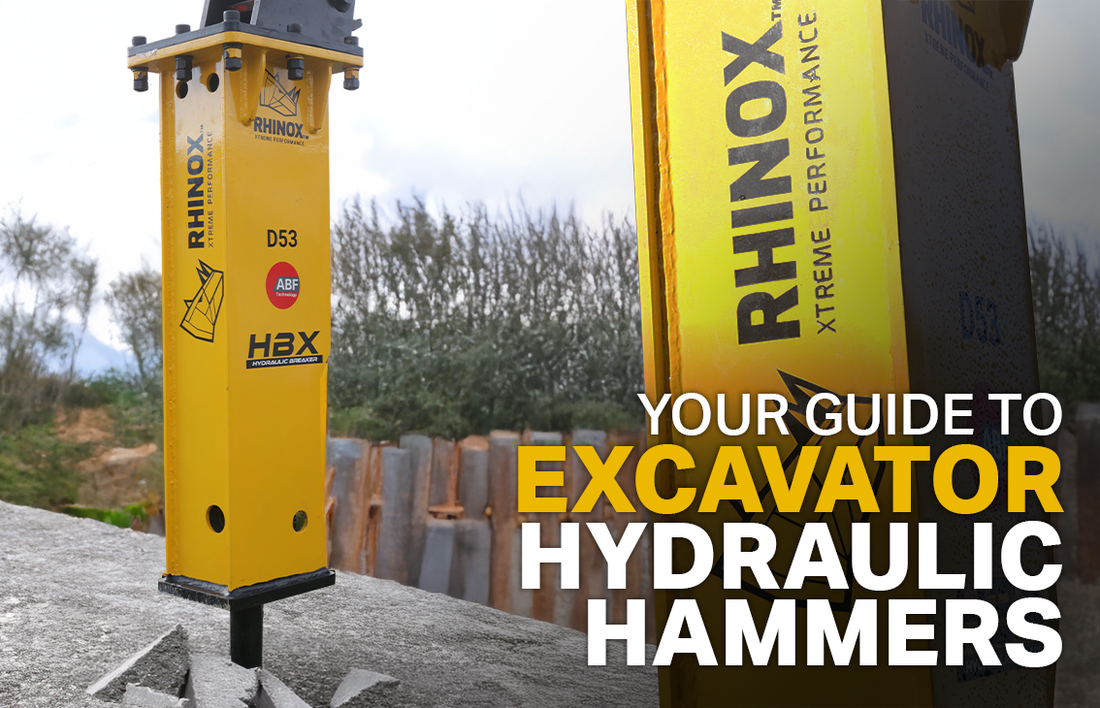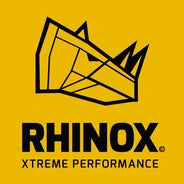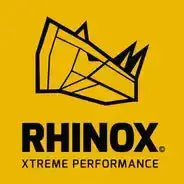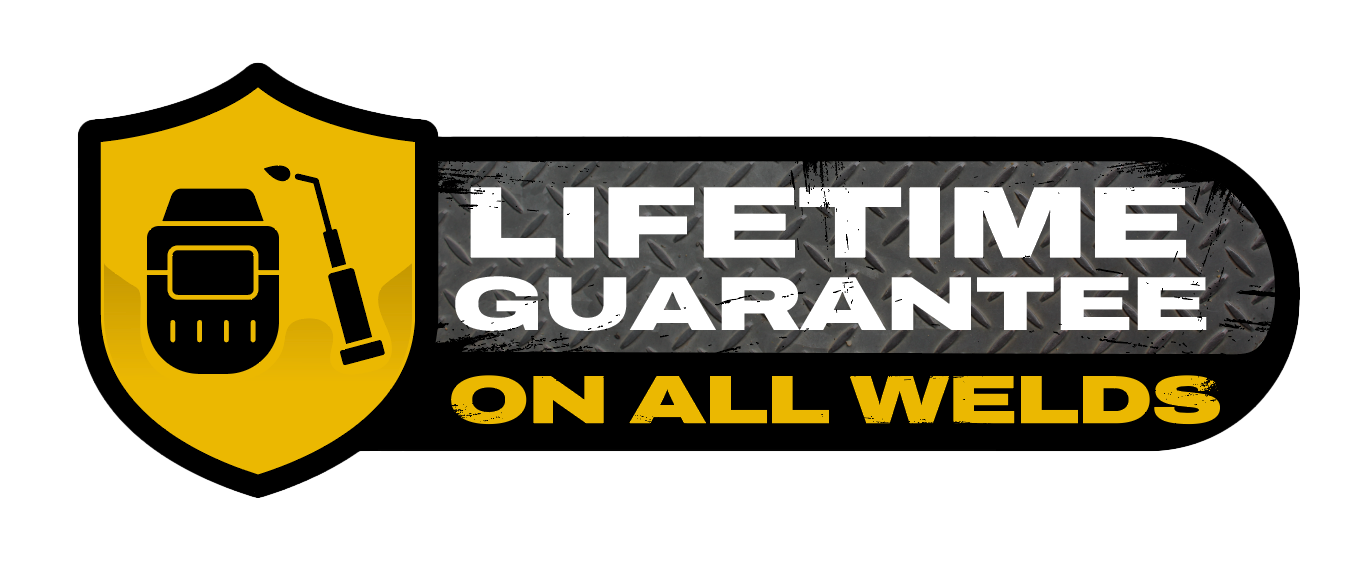
Guide to Excavator Hydraulic Hammers
When it comes to heavy-duty construction, demolition or quarrying, excavators are versatile machines - but they really shine when paired with the right attachments. One of the most powerful tools you can use on your excavator is the hydraulic hammer (also called a hydraulic breaker). In this guide, we’ll cover everything you need to know about excavator hydraulic hammers - from what they are and how they operate, to common questions, maintenance tips, and why Rhinox hydraulic hammers are a top choice for professionals. Let’s dive in and unlock the full potential of your excavator with the right hydraulic breaker.

What are Excavator Hydraulic Hammers?
A hydraulic hammer, also known as a hydraulic breaker, is a powerful excavator attachment commonly used in construction, demolition and quarrying. Hydraulic hammers work with your excavator's hydraulic pressure to drive the chisel into hard surfaces with intense, repetitive blows, making them highly effective for breaking materials like rock, concrete and asphalt. Excavator hydraulic breakers come in a range of sizes, from compact, mini excavator hydraulic hammers for small concrete demolition projects to large, heavy-duty breakers used in quarries and demolition of large structures.
5 Most Popular Questions About Excavator Hydraulic Hammers

1) Can you use a hydraulic breaker on any excavator?
Yes and no. While most excavators can be fitted with a hydraulic hammer, these attachments are not universal. Hydraulic breakers must be carefully matched to your specific machine - not just in terms of size and hydraulic flow rate, but also by the exact pickup system of your excavator. For instance, a hydraulic breaker suited in size for both a Kubota U17-3 and a Bobcat E20 will still require different mounting brackets to fit each excavator correctly - a bracket designed for one will not attach securely to the other.
More importantly, using the wrong size breaker can seriously impact your machine’s performance and longevity. A hydraulic hammer that’s too large can place excessive stress on your excavator’s boom, hydraulics and undercarriage. This can lead to premature wear, system overload, or even structural damage - repairs that are both costly and time-consuming. A breaker that’s too small for the job won’t deliver enough force to break material effectively. Resulting in longer working time, increased fuel consumption, unnecessary wear on the attachment and overall inefficiency.
In short, incorrect sizing can lead to more downtime, higher operating costs and avoidable repairs. That’s why it’s essential to confirm compatibility with the equipment manufacturer, a certified dealer or a hydraulic attachment specialist before purchasing your hydraulic breaker. They can provide recommendations based on the size of your excavator and the demands of your particular application, ensuring you get the best possible performance and return on investment from your hydraulic breaker.

2) What is “blank firing” in a hydraulic hammer?
Blank firing a hydraulic hammer occurs when the tool fires without making solid contact with a surface - essentially when the chisel strikes into the air or with no material underneath to absorb the impact. Instead of transferring energy into the rock or concrete, the force is redirected back through the hammer itself and into the excavator arm. This creates harmful shockwaves that can lead to premature wear, internal damage or even complete failure of the hydraulic breaker over time. Repeated blank firing can damage key components such as the piston, tool bushings and mounting bracket, increasing downtime and repair costs significantly.
To combat this issue, many modern excavator breakers - including Rhinox hydraulic hammers - are equipped with Anti-Blank Firing (ABF) systems. These systems are designed to detect when the hammer is not in proper contact with a surface and automatically prevents the chisel from striking unnecessarily, protecting the breaker and excavator from unnecessary damage.
3) How to use a hydraulic hammer?
Using a hydraulic hammer effectively requires understanding both the attachment and your excavator. Here’s a step-by-step guide to help you operate a hydraulic breaker safely and efficiently:
Step 1 - Attach the Hydraulic Hammer Properly
Make sure your hydraulic hammer is securely mounted to your excavator. Fit and check all hydraulic connections for leaks and ensure the breaker is compatible with your machine’s hydraulic flow and pressure specifications.
Step 2 - Check Hydraulic Pressure and Flow
Before starting, verify that your machine’s hydraulic system provides the proper pressure and flow for the hammer. Operating outside recommended settings can reduce performance or cause damage. Check the manufacturers user guide for the required information.
Step 3 - Start with the Hammer Positioned Vertically
For best results and to avoid damage, position the hydraulic hammer perpendicular to the surface you are breaking. This helps ensure maximum impact energy is transferred to the material. Running a hydraulic hammer horizontally is not recommended because using the chisel at an improper angle creates uneven pressure, which can cause breakage.
Step 4 - Apply Steady Pressure
Engage the breaker and apply steady, controlled pressure. Avoid forcing the hammer too hard against the material, as this can cause excessive wear or damage. Let the tool do the work. Make sure to work methodically - break the material in manageable sections.
4) How do I maintain a hydraulic hammer?
Proper maintenance is essential to keeping your hydraulic breaker running efficiently and extending its service life. These excavator attachments operate under intense conditions, and without regular care, they can suffer premature wear, internal damage or even catastrophic failure. Here are a few key maintenance steps every operator should follow:
• Grease the chisel with every use. This is essential to prevent metal-on-metal contact between the tool and bushings, which helps reduce friction and wear. If the grease becomes contaminated with grit or dirt, clean it off and reapply - debris can accelerate wear. Always use high-temperature, extreme-pressure moly-grease. Greasing every 2-4 hours may be necessary during extended use.

• Inspect wear parts regularly, including bushings, seals and retaining pins. These components naturally degrade over time due to impact and vibration. Replacing them before they fail will prevent further damage to internal components like the piston.
• Check hydraulic hoses and connections for leaks, cracks or wear. Hydraulic leaks not only reduce efficiency but can also allow contaminants to enter the system, causing internal damage. Ensure hoses are securely fitted and routed correctly to avoid pinch points or excessive flexing.
• Monitor nitrogen gas pressure and recharge as needed. Regular checks ensure the pressure remains within the manufacturers recommended range - both low and high pressure can cause issues. Low pressure can reduce impact force, while high pressure may damage seals and internal components. If recharging is necessary, use nitrogen gas with proper high-pressure-rated equipment, and fill slowly while monitoring the gauge. Always follow the manufacturer’s guidelines for safe and accurate pressure management.
• Follow the manufacturer’s recommended maintenance schedule. Keep a detailed log of operating hours, inspections and service intervals. Some models may require additional tasks like checking tool retainers, replacing filters or inspecting internal components after a set number of hours.
5) How do you grease a hydraulic hammer?

Greasing an excavator hydraulic hammer is a critical part of daily maintenance that directly impacts the tool’s performance and lifespan. Proper lubrication reduces metal-to-metal contact between the tool bit and bushings, helping to prevent excessive wear, overheating and costly damage over time. The best grease for a hydraulic hammer is a high-temperature, extreme-pressure (EP) moly-grease, also known as moly paste.
How To Grease a Hydraulic Hammer
- To grease a hydraulic breaker correctly, start by positioning the hammer vertically with the tool bit resting on the ground. This ensures the grease is evenly distributed around the tool and within the bushings.
- Before applying new grease, wipe away any old or contaminated grease to prevent dirt and debris from causing premature wear.
- Then, using a grease gun, apply grease through the designated grease nipple - usually located on the body of the hammer. Pump grease until fresh lubricant squeezes out around the tool bit and bushing area.
As for how often a hydraulic breaker should be greased, this depends on the intensity of use and working conditions. A general rule is to grease the hammer at least every two hours of operation, but in high-impact or dusty environments, more frequent greasing may be required - sometimes multiple times per shift.
Why Choose Rhinox Hydraulic Hammers?
When choosing a hydraulic hammer, it’s not just about power - it’s about reliability, safety and durability to keep your excavator running smoothly job after job. Rhinox hydraulic hammers (HBX) combine innovative features with rugged construction. Designed with operator safety and machine longevity in mind, Rhinox hydraulic breakers help you get the most out of every project while minimizing downtime and maintenance costs. Check out our standout features below.

Varying Sizes to Match Your Excavator
Whether you’re operating a compact or a mid-sized excavator, Rhinox offers a hydraulic hammer tailored to your needs. Our hydraulic breaker range includes four size options compatible with excavators ranging from as small as 1.5 tons - like the Kubota U17 - up to 9 tons, such as the Kubota KX080. This variety ensures that no matter your machine’s weight class or your project’s demands, there’s a Rhinox hydraulic hammer designed to deliver optimized performance without overloading your equipment.
Warranty Coverage - Confidence with Every Strike
Rhinox hydraulic hammers are backed by a 1 year or 2,000 hour warranty, whichever comes first, giving you peace of mind from the moment your excavator attachment hits the jobsite. This warranty covers the whole hydraulic hammer, ensuring protection against manufacturing defects and premature failure under normal operating conditions. While hydraulic hoses are not covered, the chisel tool is covered - provided it is used correctly. To maintain warranty coverage, the breaker and chisel must be operated in a vertical position and not at an angle, as improper use can lead to unnecessary stress and damage. Any tool damage will be evaluated on a case-by-case basis to determine warranty eligibility.
Anti-Blank Firing (ABF) System – Safety First
A standout feature of Rhinox hydraulic hammers is the integrated Anti-Blank Firing (ABF) system. This safety mechanism detects when the hammer isn’t resting on a solid surface and prevents the piston from firing unnecessarily, protecting your excavator and your breaker's internal components from damage. Using sensors to monitor downward pressure, it ensures that impacts only occur when appropriate. What truly sets our breaker range apart is that ABF is included across all hammer sizes - even small models - something most competitors skip on the smaller excavator breakers. Since this isn’t an industry-wide feature, choosing Rhinox hydraulic hammers adds extra safety to your job and improves attachment longevity. This commitment to safety means less downtime, fewer repairs and a longer lifespan for your attachment.

Optimized Power-to-Weight Ratio
Rhinox hammers are precision-engineered to deliver maximum impact energy relative to the breaker's size and weight. This means your attachment works smarter, not harder - breaking through materials more efficiently, completing jobs faster and using less fuel. Each excavator hammer is built to match your excavator’s specifications, providing full power without compromising control or safety.
Rigid Damping System - Smooth Operation & Long-Term Durability
A damping system in a hydraulic hammer is designed to absorb and reduce the shock and vibrations generated during operation. It helps protect both the hammer and the excavator by managing the forces that occur when the hammer strikes a surface. Unlike traditional rubber damping systems that can cause a spring-back effect, Rhinox uses a Rigid Damping System that relies on solid components. This design disperses energy more evenly, reducing rebound and minimizing vibration and recoil shock transmitted to your excavator. The result is less wear on the machine’s arm and hydraulics, increased operator comfort, and smoother, more stable hammering in any terrain.
Wear-Resistant Base Plate - Built for Harsh Environments
For work in rocky, dusty, or abrasive conditions, Rhinox hydraulic hammers come equipped with a specially designed wear-resistant plate at the base. This durable plate acts as a tough barrier, protecting critical internal components from the constant assault of debris, dust and direct impacts. By shielding the hammer’s internals, it significantly reduces wear and tear, helps the tool maintain peak performance even under the most demanding job site conditions. This added layer of protection not only extends the overall lifespan of the hammer but also means fewer repairs and replacements over time. As a result, you benefit from increased uptime, reduced maintenance costs, and ultimately, a stronger return on your investment.
 |
 |
 |
 |
What’s Included with the Rhinox Hydraulic Hammer?
Every Rhinox hydraulic hammer package is thoughtfully prepared to help you get started quickly. Your Rhinox hydraulic hammer will include: two flat wedge chisels, a nitrogen charging kit and a toolbox with the essential wrenches and tools for installation. The package also includes two high-quality hydraulic hoses - 78 inches for 1.5 to 3 ton excavator models and 88 inches for 4 to 9 ton excavator models. Depending on your excavator’s auxiliary port locations, you may need to source longer hoses or have the supplied hoses shortened to ensure a proper fit. All hoses feature ½ inch BSP threaded fittings. The mounting bracket specific to your excavator’s make and model is included and will need to be fitted to the hammer upon arrival, with all necessary tools for installation provided. To assist you further, Rhinox offers a clear, step-by-step installation video.
Purchasing your Rhinox Hydraulic Hammer
Ready to upgrade your excavator with a high-performance hydraulic hammer? You have two simple options - shop online to explore our full HBX hydraulic hammer range, or contact the Rhinox team directly. Our expert team can help you select the perfect hammer for your specific excavator, assist with installation advice and handle bulk orders. Whether you’re new to hydraulic breakers or expanding your fleet, Rhinox is here to help you find the ideal fit for you.







